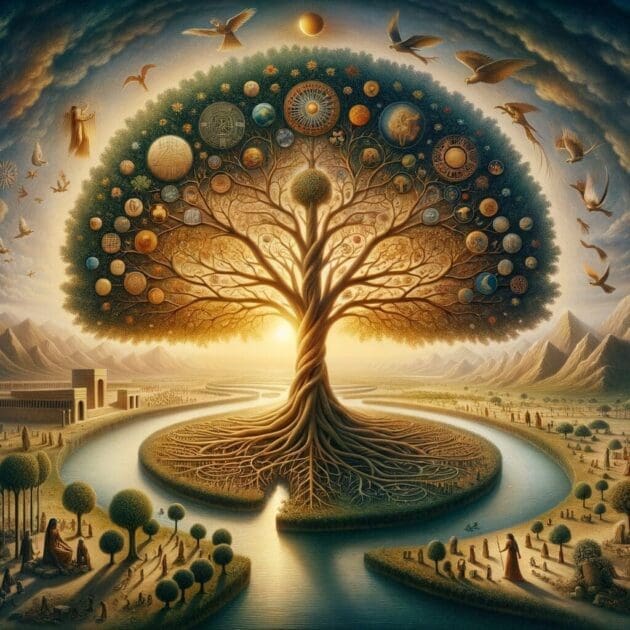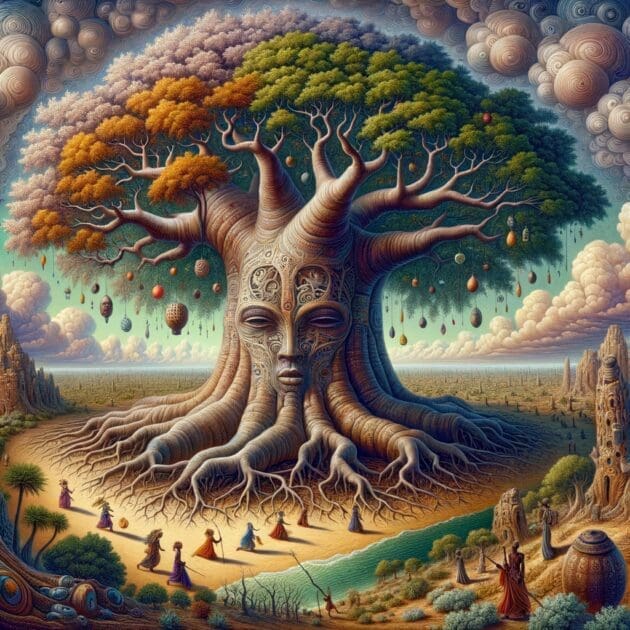Ancient Egypt Gods
Exploring the Sacred Tree of Life

The Enigmatic Tree of Life: A Journey Through Culture and Philosophy
Have you ever paused to consider the profound symbolism of a tree? Not just any tree, but the Tree of Life—a concept that transcends cultures, epochs, and philosophies. It stands as a testament to our interconnectedness, a living metaphor for growth, resilience, and the cyclical nature of existence. As we embark on this exploration, let’s meander through the branches of history, philosophy, and personal reflection, discovering how this ancient symbol resonates in our lives today.
The Tree of Life: A Universal Symbol
The Tree of Life is more than a mere botanical entity; it is a universal symbol that embodies the essence of life itself. Across various cultures, it represents the interconnectedness of all beings, the cycle of life, and the pursuit of knowledge. But what does it mean to you? How does this ancient symbol resonate in your personal journey?
In many traditions, the Tree of Life serves as a bridge between the earthly and the divine. Its roots dig deep into the soil, anchoring it to the earth, while its branches stretch toward the heavens, reaching for the stars. This duality invites us to reflect on our own lives—how we are grounded in our experiences yet aspire for something greater. It beckons us to explore our roots while nurturing our dreams.
As we delve deeper, we find that the Tree of Life is not just a static image; it is a dynamic representation of growth and transformation. Each leaf, each branch, tells a story of resilience, adaptation, and the beauty of diversity. Just as trees weather storms and seasons, so too do we navigate the challenges and changes of life. This metaphor invites us to embrace our own journeys, recognizing that growth often comes from adversity.
In this exploration, we will traverse the landscapes of the Sumerian Tree of Life, the African Tree of Life, and beyond, uncovering the rich tapestry of meanings woven into this symbol. Let’s embark on this journey together, allowing the wisdom of the ages to guide us.
The Sumerian Tree of Life: Roots in Ancient Civilization

To understand the Sumerian Tree of Life, we must first journey back to one of the world’s earliest civilizations. The Sumerians, who flourished in Mesopotamia around 4500 BCE, revered the Tree of Life as a symbol of divine connection and eternal life. It was often depicted in their art and mythology, serving as a reminder of the sacred bond between humanity and the cosmos.
In Sumerian mythology, the Tree of Life was associated with the goddess Inanna, representing fertility, love, and war. This connection highlights the multifaceted nature of life itself—how creation and destruction coexist in a delicate balance. The Sumerians understood that life is not merely a linear journey but a complex web of experiences, emotions, and relationships.
Moreover, the Sumerian Tree of Life was often depicted alongside the sacred rivers of the region, symbolizing the flow of life and the nourishment that comes from nature. This imagery invites us to reflect on our own sources of sustenance—what nourishes our souls? What rivers of inspiration flow through our lives?
As we contemplate the Sumerian Tree of Life, we are reminded of the importance of honoring our roots while reaching for the stars. It encourages us to cultivate a deep connection with our heritage, recognizing that our past shapes our present and future.
Branches of Knowledge: The Tree as a Source of Wisdom
In many cultures, the Tree of Life is also seen as a source of knowledge. The Sumerians believed that the tree held the secrets of the universe, accessible only to those who sought wisdom with an open heart. This notion resonates deeply in our modern lives—how often do we find ourselves yearning for understanding in a world filled with noise and distraction?
The branches of the Tree of Life symbolize the various paths of knowledge we can pursue. Each branch represents a different discipline, a different way of understanding the world around us. Whether it’s science, philosophy, art, or spirituality, each path offers unique insights into the human experience. This diversity enriches our lives, inviting us to explore and learn from one another.
As we navigate our own branches of knowledge, we must remember that wisdom is not a destination but a journey. It requires curiosity, humility, and a willingness to embrace the unknown. The Sumerian Tree of Life serves as a reminder that the pursuit of knowledge is a lifelong endeavor, one that connects us to the past while illuminating our path forward.
Personal Reflection: What Does the Tree of Life Mean to You?
As we reflect on the Sumerian Tree of Life, I invite you to consider what this symbol means in your own life. How do you connect with your roots? What branches of knowledge are you exploring? Take a moment to pause and reflect on your journey—what lessons have you learned along the way? How can you honor your past while reaching for your dreams?
In this fast-paced world, it’s easy to lose sight of our connection to the natural world and the wisdom it offers. The Tree of Life invites us to slow down, to breathe, and to reconnect with the essence of who we are. It encourages us to cultivate a sense of gratitude for the experiences that have shaped us and to embrace the beauty of our unique journeys.
Conclusion: The Sumerian Legacy
The Sumerian Tree of Life stands as a powerful symbol of our interconnectedness, inviting us to explore the depths of our existence. It reminds us that we are part of a larger tapestry, woven together by the threads of history, culture, and shared experiences. As we honor our roots and nurture our branches, we can cultivate a deeper understanding of ourselves and the world around us.
The African Tree of Life: A Symbol of Resilience and Community

As we shift our focus to the African Tree of Life, we encounter a rich tapestry of meanings that reflect the diverse cultures and traditions across the continent. In many African societies, the Tree of Life symbolizes resilience, community, and the interconnectedness of all living beings. It serves as a reminder that we are not solitary beings but part of a larger ecosystem, bound together by shared experiences and mutual support.
The African Tree of Life often takes the form of the Baobab tree, known for its massive trunk and longevity. This tree is not just a physical entity; it embodies the spirit of the community. Its branches provide shelter, its fruit nourishes, and its bark is used for various purposes. The Baobab tree stands as a testament to the importance of community and the interconnectedness of life.
In many African cultures, storytelling is an integral part of life, and the Tree of Life often features prominently in these narratives. It serves as a backdrop for tales of wisdom, resilience, and the human experience. These stories remind us that we are all part of a larger narrative, one that transcends time and space. They invite us to reflect on our own stories—what lessons have we learned? How can we contribute to the collective narrative of humanity?
Roots of Resilience: The Baobab Tree
The Baobab tree, often referred to as the “Tree of Life,” is a powerful symbol of resilience in African culture. Its ability to thrive in harsh conditions serves as a metaphor for the human spirit’s capacity to endure and overcome adversity. Just as the Baobab stands tall against the elements, so too do we face challenges in our lives.
This resilience is not merely an individual trait; it is a communal strength. In many African societies, the concept of Ubuntu—“I am because we are”—emphasizes the importance of community and interconnectedness. The Baobab tree embodies this philosophy, reminding us that our strength lies in our relationships with one another.
As we reflect on the Baobab tree, we are invited to consider how we can cultivate resilience in our own lives. What support systems do we have in place? How can we nurture our connections with others? The Tree of Life encourages us to lean on one another, recognizing that we are stronger together.
Branches of Community: The Importance of Connection
The branches of the African Tree of Life symbolize the importance of community and connection. In many cultures, gatherings around the tree serve as a space for dialogue, storytelling, and celebration. These communal experiences foster a sense of belonging and reinforce the bonds that unite us.
In our modern lives, it’s easy to feel isolated amidst the hustle and bustle. The African Tree of Life invites us to seek out our own communities—whether they be family, friends, or like-minded individuals. It encourages us to create spaces where we can share our stories, support one another, and celebrate our shared humanity.
As we navigate our own branches of community, let’s remember the power of connection. How can we reach out to others? How can we create spaces for dialogue and understanding? The Tree of Life serves as a reminder that we are all part of a larger tapestry, woven together by our shared experiences and aspirations.
Personal Reflection: What Does Community Mean to You?
As we contemplate the African Tree of Life, I invite you to reflect on the role of community in your life. Who are the individuals that support you? How do you contribute to the well-being of those around you? Take a moment to consider how you can strengthen your connections and foster a sense of belonging.
In a world that often emphasizes individualism, the African Tree of Life reminds us of the importance of community. It encourages us to cultivate relationships that nourish our souls and uplift those around us. By embracing our interconnectedness, we can create a more compassionate and resilient world.
Conclusion: The African Legacy
The African Tree of Life stands as a powerful symbol of resilience and community, inviting us to reflect on our interconnectedness. It reminds us that we are part of a larger narrative, woven together by the threads of shared experiences and mutual support. As we honor our roots and nurture our connections, we can cultivate a deeper understanding of ourselves and the world around us.
Bridging Cultures: The Global Significance of the Tree of Life
As we traverse the landscapes of the Sumerian and African Trees of Life, we begin to see a common thread that unites these diverse cultures. The Tree of Life serves as a bridge between civilizations, embodying universal themes of growth, resilience, and interconnectedness. It invites us to explore the rich tapestry of human experience, recognizing that our stories are intertwined.
In many cultures, the Tree of Life symbolizes the cycle of life, death, and rebirth. It serves as a reminder that every ending is a new beginning, encouraging us to embrace change and transformation. This cyclical nature resonates deeply in our personal journeys—how often do we find ourselves at a crossroads, faced with choices that shape our paths?
The Tree of Life also embodies the pursuit of knowledge and understanding. Across cultures, it represents the quest for wisdom, inviting us to explore the depths of our existence. This pursuit is not merely an intellectual endeavor; it is a spiritual journey that connects us to something greater than ourselves.
Common Themes: Growth, Resilience, and Interconnectedness
As we reflect on the common themes that emerge from our exploration of the Tree of Life, we are reminded of the importance of growth and resilience. Just as trees adapt to their environments, so too do we navigate the challenges and changes of life. This adaptability is a testament to the human spirit’s capacity to endure and thrive.
The interconnectedness of all beings is another profound theme that resonates across cultures. The Tree of Life serves as a reminder that we are not isolated entities but part of a larger ecosystem. Our actions ripple through the fabric of existence, influencing those around us. This awareness invites us to cultivate compassion and empathy, recognizing that our well-being is intertwined with that of others.
Personal Reflection: How Do You Connect with the Global Community?
As we contemplate the global significance of the Tree of Life, I invite you to reflect on your own connections with the world. How do you engage with diverse cultures and perspectives? What steps can you take to foster understanding and compassion in your interactions with others?
In a world that often feels divided, the Tree of Life encourages us to seek out common ground. It invites us to celebrate our shared humanity while honoring our unique differences. By embracing this interconnectedness, we can create a more harmonious and compassionate world.
Conclusion: A Call to Action
The Tree of Life stands as a powerful symbol of growth, resilience, and interconnectedness. It invites us to reflect on our own journeys while recognizing our place within the larger tapestry of existence. As we honor our roots and nurture our connections, let us embrace the wisdom of the ages and strive to create a more compassionate world.
Q&A: Common Questions About the Tree of Life
- What is the significance of the Tree of Life? The Tree of Life symbolizes interconnectedness, growth, and the cycle of life across various cultures.
- How does the Sumerian Tree of Life differ from the African Tree of Life? While both symbolize resilience and interconnectedness, the Sumerian Tree is often associated with divine connection, whereas the African Tree emphasizes community and support.
- What can I learn from the Tree of Life? The Tree of Life teaches us about the importance of honoring our roots, nurturing our connections, and embracing the journey of growth and transformation.
- How can I apply the lessons of the Tree of Life in my life? Reflect on your connections with others, seek out knowledge, and embrace change as a natural part of your journey.
- Where can I learn more about the Tree of Life? Explore resources such as books, documentaries, and online courses that delve into the cultural significance and symbolism of the Tree of Life.
As we conclude this exploration of the Tree of Life, I invite you to carry its wisdom with you. Let it inspire you to honor your roots, nurture your connections, and embrace the journey of growth. Together, we can create a more compassionate and interconnected world.
For further insights and resources, consider downloading our free eBook, subscribing to our newsletter, or exploring our YouTube channel.
🎥 Featured Spiritual Growth Video
🏆 Top 3 Most Watched Videos

